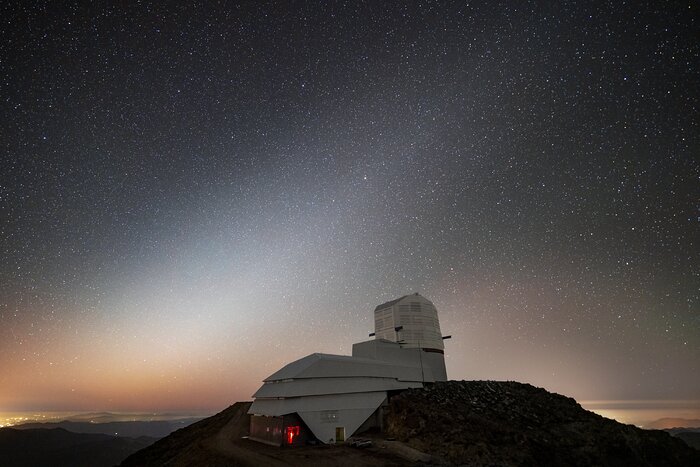Un velo celestial sobre el Observatorio Rubin
El Observatorio Vera C. Rubin se encuentra bajo la tenue luz de un fascinante fenómeno astronómico conocido como luz zodiacal. Caracterizado por su delicado resplandor en forma cónica, este fenómeno se extiende a lo largo del plano orbital que recorren los planetas y el Sol (conocido como la eclíptica) y es producto de la luz solar dispersada por el polvo interplanetario que se encuentra en nuestro Sistema Solar. Este fenómeno se observa con mayor facilidad en el cielo hacia el oeste justo después de la puesta de Sol, o en el cielo hacia el este, justo antes del amanecer. Se cree que el polvo lo dejan las colas de los cometas y las colisiones entre asteroides. La luz zodiacal es tenue y suele perderse debido a la contaminación lumínica del cielo o el resplandor de la Luna.
El Observatorio Vera C. Rubin de NSF-DOE es financiado por la Fundación Nacional de Ciencias (NSF) y la Oficina de Ciencias del Departamento de Energía de Estados Unidos (DOE/SC por sus siglas en inglés). El Observatorio Rubin es un Programa de NOIRLab de NSF, que, junto con el Laboratorio Nacional del Acelerador SLAC del DOE, serán los encargados de las operaciones de Rubin.
El Observatorio Rubin se está construyendo en Cerro Pachón, en Chile, uno de los mejores lugares de observación del hemisferio sur, lo que lo convierte en un lugar idóneo para captar un espectáculo tan poco frecuente como la luz zodiacal. Cuando esté terminado, Rubin utilizará su espejo de 8,4 metros, combinado con la cámara más grande construida para la astronomía, para iniciar un ambicioso estudio del cielo austral que durará diez años, denominado la Investigación del Espacio-Tiempo como Legado para la posteridad (LSST por sus siglas en inglés), que ayudará a responder algunas de las preguntas más importantes sobre el Universo. El Observatorio Rubin comenzará sus operaciones científicas a finales de 2025.
Esta fotografía fue tomada por Hernán Stockebrand, Embajador Audiovisual de NOIRLab.
Créditos:RubinObs/NOIRLab/SLAC/NSF/DOE/AURA/H. Stockebrand
About the Image
| Id: | iotw2422a |
| Idioma: | es |
| Tipo: | Photographic |
| Release date: | 29 de Mayo de 2024 a las 12:00 |
| Size: | 7710 x 5143 px |
Sobre el Objeto
| Nombre: | Vera C. Rubin Observatory |
| Categoría: | Vera C. Rubin Observatory |
